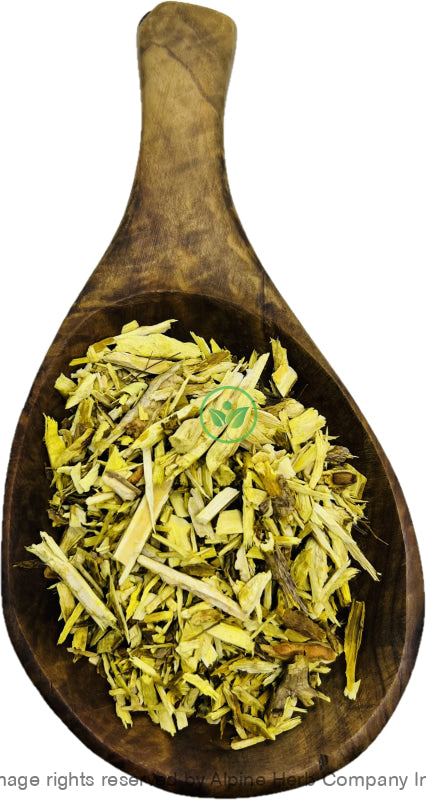Oregon Grape Root Cut Alpine Herb Company Inc.
$ 15,49 $ 9,29
Botanical Name: Berberis aquifolium
Common Name:
- English: Oregon Grape
- Also, known as: Mountain-Grape, Oregon Barberry, Oregon-Grape, Oregon Grape-Holly, Barberry, Berberis aquifolium, Berberis nervosa, Berberis repens, Berberis sonnei, Blue Barberry, Creeping Barberry, Holly Barberry, Holly-Leaved Berberis, Holly Mahonia, Mahonia, Mahonia aquifolium, Mahonia diversifolia, Mahonia Faux Houx, Mahonia à Feuilles de Houx, Mahonia nervosa, Mahonia repens, Mahonie, Mountain-Grape, Oregon Barberry, Oregon-Grape, Oregon Grape-Holly, Scraperoot, Trailing Mahonia, Uva de Oregon, Vigne de l’Oregon, Water-Holly.
Origin: Usa
Harvested: Wild
Parts Used: Root
General Information:
Berberis aquifolium, is an evergreen shrub growing to 5-10 feet tall by 5 feet wide, although it can be trained to grow taller and spreads slowly by rhizomes. It is known by a large variety of different common names including Oregon holly grape, Oregon grape holly or Oregon grape. It is noted for its yellow flowers in spring, edible blue-black berries in late summer, pinnately compound evergreen foliage and ability to grow well in shade. Holly leaved Oregon grape is so called for its shiny, leathery leaflets with pointed, toothy margins. Unlike holly, however, its leaves are compound. Each compound leaf, up to 10-inch-long has 5-9 spiny, ovate to oblong-ovate leaflets, dark green and holly shaped, and will often turn to hues of red and purple in the winter. New leaves emerge red-tinted in spring, maturing to glossy dark green by summer. Foliage acquires purplish hues in fall and burgundy-bronze tones by winter, sometimes suffering from winter burn. It produces masses of bright yellow flowers that later mature into blue berries with a velvety sheen, which give rise to the common name “Oregon grape”. Flowers are mildly fragrant. The Oregon grape is not related to true grapes, but gets its name from the purple clusters of edible berries whose color and slightly dusted appearance are reminiscent of grapes. Birds and small wildlife are attracted to these berries, but they’ll usually leave enough for you to admire. The contrast between the blue fruits and the glossy green foliage is picture perfect.
The leaves, bark, and roots of this species have been used by many Native American tribes to treat many ailments. Found wild in the western states. Thee flower is the State Flower of Oregon, hence the common name. An evergreen shrub, this Oregon Grape is good looking all year. Wintertime, Oregon Grape will color it’s leaves to bronze, only to green up again when spring comes around.
How to use:
Decoctions are suitable for roots, barks, large seeds & berries, and other dense material. The simple way to make decoction is, in a saucepan, add 1 tablespoon of dried herbs to 1 cup of water. Bring the water to boil, reduce heat and simmer for 30-60 minutes. Strain and squeeze out as much as liquid as possible and enjoy!
Tips:
- You can sweeten your herbal decoctions with a bit of honey, natural fruit juice, stevia leaves powder and or licorice root powder.
Precautions:
You should consult with a qualified healthcare practitioner before using any herbal products, particularly if you are pregnant, nursing, or on any medications.
All information on this website is for educational purposes ONLY.
This information has not been evaluated by Health Canada.
This information is not intended to diagnose, treat, cure, or prevent any disease.
| Unit Size | 100g, 200g, 400g, 1kg |
|---|
Prompt shipping and expert packing
Thanks to our longstanding association with UPS FedEx DHL as well as other leading global carriers, we can offer a variety shipping options. Our warehouse staff is highly trained and will be able to pack your goods in accordance with our precise and exact specifications. Your items will go through an exhaustive examination before they will be securely packaged before being delivered. We ship to hundreds of thousands of customers daily in different countries. This is a sign of our determination to become the largest online retailer worldwide. Warehouses and distribution centers are located throughout Europe as well as in the USA.
Note that orders containing multiple items are processed according to the particular item.
We will thoroughly inspect all items ordered before shipping. Most orders are shipped within 48 hours. The delivery time will be between 3 and 7 working days.
Returns
The stock market is always changing. It's not entirely managed by us since we're involved with several entities, including the factory and the storage. Therefore, the actual inventory could fluctuate at any moment. Please be aware that it is possible that your order could be out of stock after you've placed your order.
Our policy lasts for 30 days. If it's been more than 30 days since the date you purchased your item We're sorry to say that we can't offer you a full exchange or refund.
You can only return a product if it is unused and still in the same state as when you received it. The item should be in the original packaging.


































